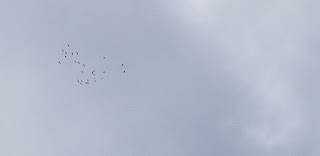Natural Notes: Trills from the urban sky

If you're out prepping your garden bed for winter, listen closely. A little more closely! Alongside the noise of the city and up in the sky, you might here a chorus of trills. Look up! Those hauntingly primeval sounds might be those of the Sandhill Crane ( Antigone canadensis ). Yes, we have cranes in the Chicago region! And right around Thanksgiving is one of the best times to see flocks of them flying over (figure 1) as they make their way south for the winter. In fact, over 80,000 of these elegant, heron-like birds with wingspans in excess of 6 feet fly over the Chicago region during fall and spring migration each year. Figure 1: A flock of migrating Sandhill Cranes in flight. If you are a city dweller, more often than not the best view you'll get of these birds is like the one shown in Figure 1. As such, people often confuse them with geese. However, just a few extra moments of observation is al...





